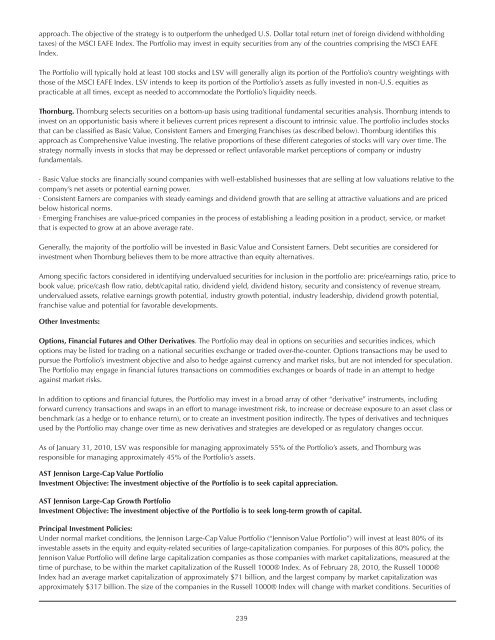Advanced Series Trust AST Academic Strategies Asset ... - Prudential
Advanced Series Trust AST Academic Strategies Asset ... - Prudential
Advanced Series Trust AST Academic Strategies Asset ... - Prudential
You also want an ePaper? Increase the reach of your titles
YUMPU automatically turns print PDFs into web optimized ePapers that Google loves.
approach. The objective of the strategy is to outperform the unhedged U.S. Dollar total return (net of foreign dividend withholding<br />
taxes) of the MSCI EAFE Index. The Portfolio may invest in equity securities from any of the countries comprising the MSCI EAFE<br />
Index.<br />
The Portfolio will typically hold at least 100 stocks and LSV will generally align its portion of the Portfolio’s country weightings with<br />
those of the MSCI EAFE Index. LSV intends to keep its portion of the Portfolio’s assets as fully invested in non-U.S. equities as<br />
practicable at all times, except as needed to accommodate the Portfolio’s liquidity needs.<br />
Thornburg. Thornburg selects securities on a bottom-up basis using traditional fundamental securities analysis. Thornburg intends to<br />
invest on an opportunistic basis where it believes current prices represent a discount to intrinsic value. The portfolio includes stocks<br />
that can be classified as Basic Value, Consistent Earners and Emerging Franchises (as described below). Thornburg identifies this<br />
approach as Comprehensive Value investing. The relative proportions of these different categories of stocks will vary over time. The<br />
strategy normally invests in stocks that may be depressed or reflect unfavorable market perceptions of company or industry<br />
fundamentals.<br />
· Basic Value stocks are financially sound companies with well-established businesses that are selling at low valuations relative to the<br />
company’s net assets or potential earning power.<br />
· Consistent Earners are companies with steady earnings and dividend growth that are selling at attractive valuations and are priced<br />
below historical norms.<br />
· Emerging Franchises are value-priced companies in the process of establishing a leading position in a product, service, or market<br />
that is expected to grow at an above average rate.<br />
Generally, the majority of the portfolio will be invested in Basic Value and Consistent Earners. Debt securities are considered for<br />
investment when Thornburg believes them to be more attractive than equity alternatives.<br />
Among specific factors considered in identifying undervalued securities for inclusion in the portfolio are: price/earnings ratio, price to<br />
book value, price/cash flow ratio, debt/capital ratio, dividend yield, dividend history, security and consistency of revenue stream,<br />
undervalued assets, relative earnings growth potential, industry growth potential, industry leadership, dividend growth potential,<br />
franchise value and potential for favorable developments.<br />
Other Investments:<br />
Options, Financial Futures and Other Derivatives. The Portfolio may deal in options on securities and securities indices, which<br />
options may be listed for trading on a national securities exchange or traded over-the-counter. Options transactions may be used to<br />
pursue the Portfolio’s investment objective and also to hedge against currency and market risks, but are not intended for speculation.<br />
The Portfolio may engage in financial futures transactions on commodities exchanges or boards of trade in an attempt to hedge<br />
against market risks.<br />
In addition to options and financial futures, the Portfolio may invest in a broad array of other “derivative” instruments, including<br />
forward currency transactions and swaps in an effort to manage investment risk, to increase or decrease exposure to an asset class or<br />
benchmark (as a hedge or to enhance return), or to create an investment position indirectly. The types of derivatives and techniques<br />
used by the Portfolio may change over time as new derivatives and strategies are developed or as regulatory changes occur.<br />
As of January 31, 2010, LSV was responsible for managing approximately 55% of the Portfolio’s assets, and Thornburg was<br />
responsible for managing approximately 45% of the Portfolio’s assets.<br />
<strong>AST</strong> Jennison Large-Cap Value Portfolio<br />
Investment Objective: The investment objective of the Portfolio is to seek capital appreciation.<br />
<strong>AST</strong> Jennison Large-Cap Growth Portfolio<br />
Investment Objective: The investment objective of the Portfolio is to seek long-term growth of capital.<br />
Principal Investment Policies:<br />
Under normal market conditions, the Jennison Large-Cap Value Portfolio (“Jennison Value Portfolio”) will invest at least 80% of its<br />
investable assets in the equity and equity-related securities of large-capitalization companies. For purposes of this 80% policy, the<br />
Jennison Value Portfolio will define large capitalization companies as those companies with market capitalizations, measured at the<br />
time of purchase, to be within the market capitalization of the Russell 1000® Index. As of February 28, 2010, the Russell 1000®<br />
Index had an average market capitalization of approximately $71 billion, and the largest company by market capitalization was<br />
approximately $317 billion. The size of the companies in the Russell 1000® Index will change with market conditions. Securities of<br />
239

















